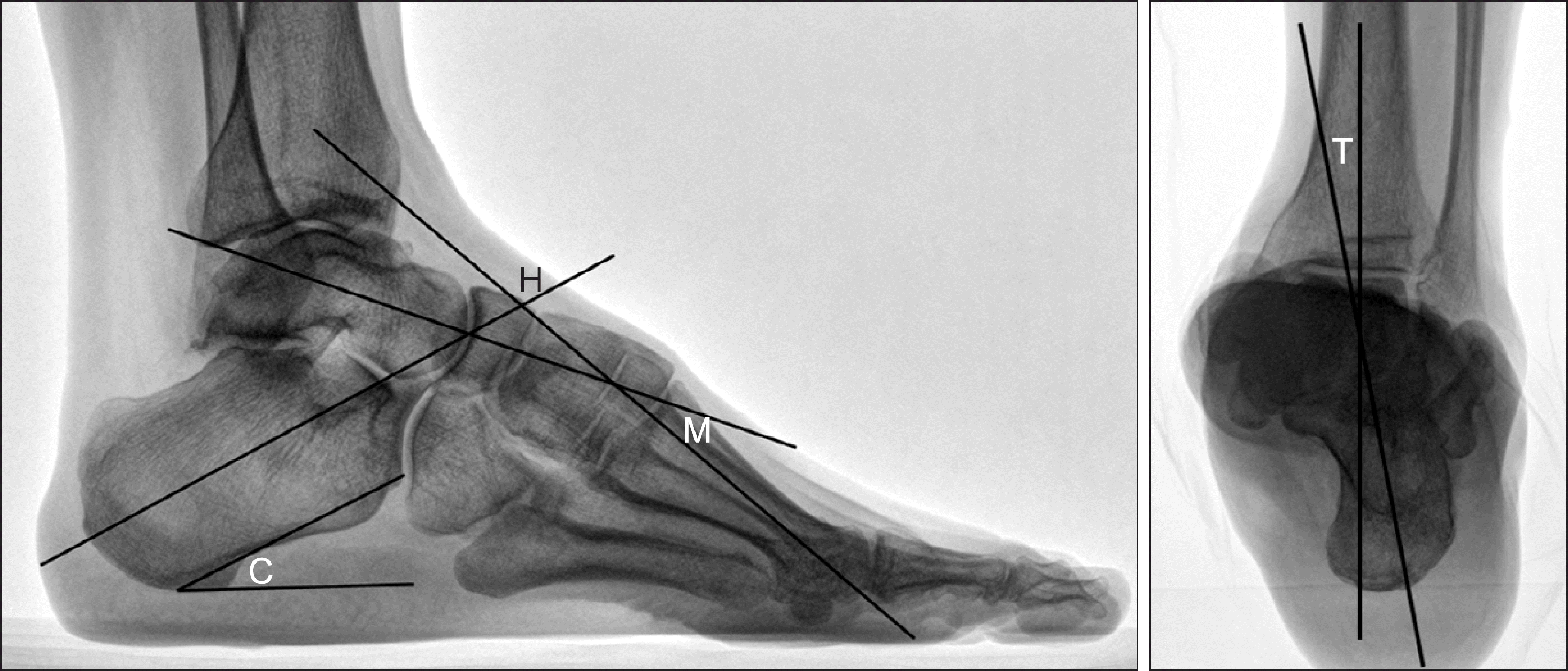Abstract
Purpose
Reconstructive surgeries for equinocavovarus foot deformities are quite variable, including hind-midfoot osteotomy or arthrodesis, soft tissue procedure, tendon transfers, etc. Comprehensive evaluation of the deformity and its etiology is mandatory for achievement of successful deformity correction. Few studies in this field have been reported. We report on the clinical and radiographic outcome of reconstruction for cavovarus foot deformities.
Materials and Methods
The study is based on 16 feet with cavovarus foot deformities that underwent bony and soft tissue reconstructive surgery from 2004 to 2008. We evaluated the etiologies, varieties of surgical procedures performed, pain score, functional scores, and patient satisfaction and measured the radiographic parameters.
Results
The average age at the time of surgery was 39.4 years old, with a male/female ratio of 9/4 and an average follow-up period of 23.9 months (range, 12∼49 months). The etiologies of the cavovarus deformity were idiopathic 7 feet, residual poliomyelitis 5 feet, Charcot-Marie-Tooth disease 2 feet, and Guillain-Barre syndrome and hemiplegia due to cerebrovascular accident sequela 1 foot each. Lateral sliding calcaneal osteotomies were performed in 12 feet (75%), followed by Achilles tendon lengthening and plantar fascia release in 11 feet (69%), and first metatarsal dorsiflexion osteotomy/arthrodesis and tendon transfer in 10 feet (63%). Visual analogue scale pain score showed improvement, from an average of 4.2 to 0.5 points. American Orthopaedic Foot and Ankle Society ankle-hindfoot score showed significant improvement, from 47.8 to 90.0 points (p<0.05). All patients were satisfied. Ankle range of motion improved from 27.5o to 46.7o. In radiographic measurements, calcaneal pitch angle improved from 19.1o to 15.8o, Meary angle from 13.0o to 9.3o, Hibb's angle from 44.3o to 37.0o, and tibio-calcaneal axis angle from varus 17.5o to varus 1.5o.
References
2. Giannini S, Ceccarelli F, Benedetti MG, Faldini C, Grandi G. Surgical treatment of adult idiopathic cavus foot with plantar fasciotomy, naviculocuneiform arthrodesis, and cuboid osteotomy. A review of thirty-nine cases. J Bone Joint Surg Am. 2002; 84(Suppl 2):62–9.
3. Sammarco GJ, Taylor R. Cavovarus foot treated with combined calcaneus and metatarsal osteotomies. Foot Ankle Int. 2001; 22:19–30.

4. Wülker N, Hurschler C. Cavus foot correction in adults by dorsal closing wedge osteotomy. Foot Ankle Int. 2002; 23:344–7.

5. Chu IT, Park JM, Yoo JM, Chung JW. Combined first metatarsal and calcaneal osteotomy for fixed cavovarus deformity of the foot. J Korean Foot Ankle Soc. 2010; 14:130–4.
6. Kitaoka HB, Alexander IJ, Adelaar RS, Nunley JA, Myerson MS, Sanders M. Clinical rating systems for the ankle-hindfoot, midfoot, hallux, and lesser toes. Foot Ankle Int. 1994; 15:349–53.

7. McCluskey WP, Lovell WW, Cummings RJ. The cavovarus foot deformity. Etiology and management. Clin Orthop Relat Res. 1989; 247:27–37.
8. Beals TC, Nickisch F. Charcot-Marie-Tooth disease and the cavovarus foot. Foot Ankle Clin. 2008; 13:259–74.

9. Coleman SS, Chesnut WJ. A simple test for hindfoot flexibility in the cavovarus foot. Clin Orthop Relat Res. 1977; 123:60–2.

10. Samilson RL, Dillin W. Cavus, cavovarus, and calcaneocavus. An update. Clin Orthop Relat Res. 1983; 177:125–32.
Figure 1.
Plain weight bearing lateral radiograph shows the Meary angle (M), Hibb's angle (H), calcaneal pitch angle (C), and tibio-calcaneal axis angle (T).

Figure 2.
Plain weight bearing lateral radiographs of a 34-year-old female with idiopathic cavovarus foot; preoperative (A) and postoperative (B).

Table 1.
Summary of Main Surgical Procedure for the Cavovarus Foot
Table 2.
Summary of the Results of the Cavovarus Foot Patients




 PDF
PDF ePub
ePub Citation
Citation Print
Print


 XML Download
XML Download